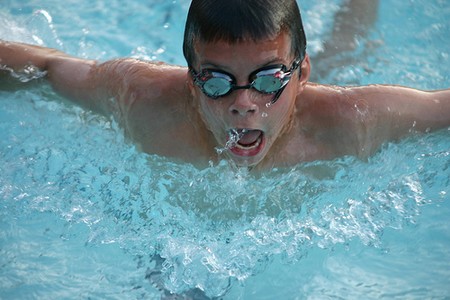Arm Movements
Standing out of the water, have the children put both of their arms out straight in front of them and push them down to the legs. They should keep pushing back as far as the arms can go. At this point the palms of the hands should be turned upward. With a roll of the shoulders, they should bring their arms over and around, so that they brush past their ears and arrive back at the original position. Repeat this a few times.
Kicking
Back in the water say to them, “Take a deep breath, face in the water, and butterfly across the pool.”
One small voice: “Kicking too?”
“No, Gregory, I purposely didn’t say anything about kicking; do whatever you like.”
So the small group takes off. Two out of the four children will do a natural dolphin kick, one will drag his feet behind and move only his arms, and the other will do freestyle kicking with the butterfly arms. Keep repeating this and don’t correct any of the kicking at all, just make sure that the arm stroke resembles the butterfly stroke.
Breathing
There are two ways of breathing for the butterfly. One is to breathe every stroke (remember you always start counting a stroke in the front), and the other is to breathe on every second stroke.
When children are learning, it’s easier for them to start off breathing on every second stroke, and when they get stronger and more efficient they can return to breathing on every stroke.
Have the children hang on to the edge of the pool and do some breathing and bubbling, lifting their heads vertically.
“Try to take a quick breath and then try to blow out a very slow long bubble.”
First the teacher should demonstrate this, standing out of the pool. Arms stretched out in front, take a breath and bring your head down as if it is going into the water. Keep your head down for the completion of the first stroke; then, still holding your head down, make a complete circle again to finish the second stroke. This sounds highly technical, but in practice it’s really easy.
Have the children practice this first standing in shoulder-deep water, then walking along the pool. When the teacher is satisfied that all the children are breathing in at the beginning of the first stroke, she can then ask them to try to do it while they swim. Even at this stage there shouldn’t be any correction or advice given on the kicking. This way even a four-year-old can butterfly ten or fifteen yards, doing the correct butterfly arm stroke and breathing without much effort.
WALKING IN PAIRS
To practice breathing and to make it easier, the children could do the following exercise.
Try to select children who are the same size and pair them off, in the pool, one in front of the other, facing the same direction. The one in the front will lift both his legs up, stretch them out, and hold them still. The other child behind grabs the legs and holds on to them like a wheelbarrow, then starts walking forward slowly pushing the “working-horse.” The “working-horse” starts butterflying, moving his arms and breathing. At the end of the pool the two should change positions and do the same thing coming back.
Doing the butterfly this way is fun and the children seem to love it. Walking in pairs can be used for breaststroke breathing too.
